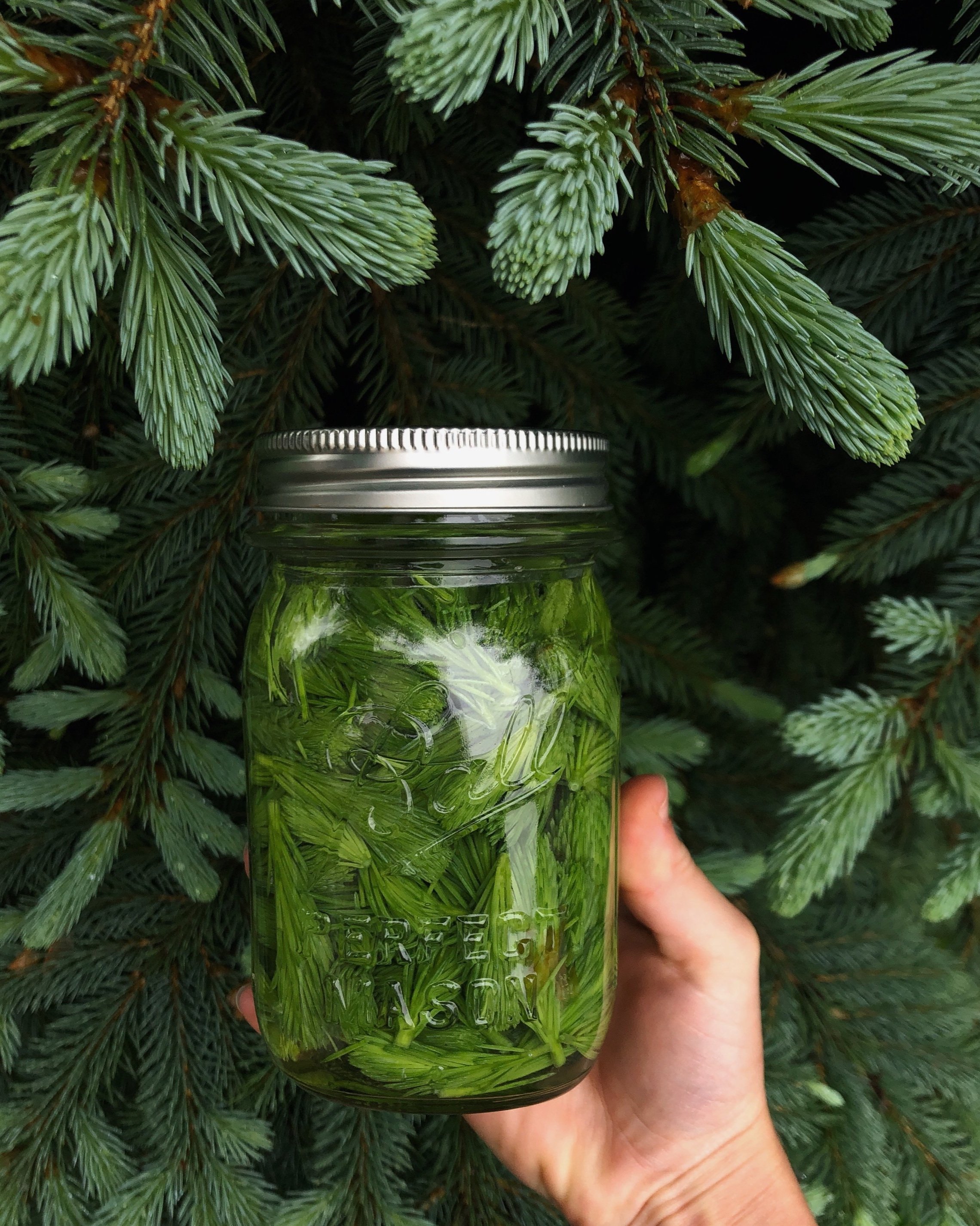Plant Medicine: Spruce Tips Benefits and Uses
One of the best ways to cultivate a productive property is to get creative with the things that grow freely in your yard and landscaping. Do you have access to a large spruce tree? Late spring is the season to take advantage of this beautiful plant! Spruce tips are the new growth of the trees each year and are most notably antiseptic, antimicrobial and an incredible source of vitamin C. After a long winter, they offer an immune boost and a fresh, lemony flavor that wakes you up from your hibernation slumber.
We have a very large, mature Blue Spruce tree in our front yard and an even larger Brewer’s Spruce in the backyard. We’ve only recently started taking advantage of them in the spring— harvesting the tips and using them as medicine! Because this is such an accessible thing to forage, I wanted to give it a spotlight here on the blog. There’s lots that can be done with them!
This year at Christmastime I’m going to be sharing the most delicious “Christmas Tea” recipe that uses spruce tips— so if you have access to them, you’re definitely going to want to pop some in your freezer for December!
Spruce tip Benefits
Extremely high in vitamin C when fresh, frozen, or dried
Also contains vitamin A and E
Natural expectorant—traditionally used for coughs and colds
Soothes sore throats
Antifungal, antimicrobial, and antiseptic
Good source of minerals such as magnesium and potassium
And so much more! It’s really interesting to research how indigenous tribes used beautiful spruce in their daily lives. Definitely one to keep in your home apothecary!
Harvesting Spruce Tips
Always make sure you are foraging what you believe to be. It’s always a good idea to fully prepare by studying the anatomy before harvesting any wild plants. All spruce is edible, but plants of the Yew species are “look alikes” to the untrained eye that are toxic and cannot be consumed. Click here for a guide to identifying conifers.
Always be sure to forage from areas that have not been sprayed in many years— 7 at the very least as they say that 7 years is the minimum detox period of glyphosate and other herbicides.
Never take more than 20% of the spruce tips from a tree. Try to pick the ones that are on branches that will be tucked away anyways. Harvest from old mature trees, not young ones.
Spruce tip Uses
Later in the year, I will be sharing a Christmas tea recipe that uses the spruce tips I’m freezing this spring. We are also enjoying them in fresh teas now and drying them out to make a balm that will be available in the shop in December. Here are a few creative ways you can use spruce tips in your own home:
Spruce tip tincture
Spruce tip syrup
Spruce tip tea
Freeze spruce tips for winter use
Dry spruce tips for winter use
Spruce tip infused oil
Spruce tip jelly
An important disclaimer about wild plants and foraging
I am not a medical professional and nothing written on this blog is medical advice. None of my statements have been evaluated by the FDA (I am legally required to give you this disclaimer).
It is important to do your due diligence before foraging, harvesting, and consuming any type of new medicinal plant.
If you are taking any medications, talk to your doctor about any potential drug interactions.
If you are allergic to anything, make sure whatever you are foraging is not in the same family.
Always research potential side effects, dosage recommendations, and how to properly prepare and consume each medicinal plant. Always make sure you are foraging what you believe to be. Fully prepare and study the anatomy before harvesting wild plants. Do not forage plants from areas that have been sprayed within the past 7 years. I am not legally or morally responsible for the health of any of my readers. Please do your own research.
For more “weeds that heal” check out Rachel Weaver’s book Back Yard Pharmacy. I’d love to hear what you do with spruce tips in your own home apothecary! Happy foraging :)
More posts about the home apothecary…
This post is not medical advice and is not a substitute for consulting with your doctor. Always do your own research and talk to your medical health professional before introducing any new herbs into your daily routine. Be aware of any allergies you may have and herbal interactions with medications you take. Nothing in this post has been evaluated by the FDA and is not intended to cure, treat, diagnose, or prevent any disease. This post contains affiliate links.









